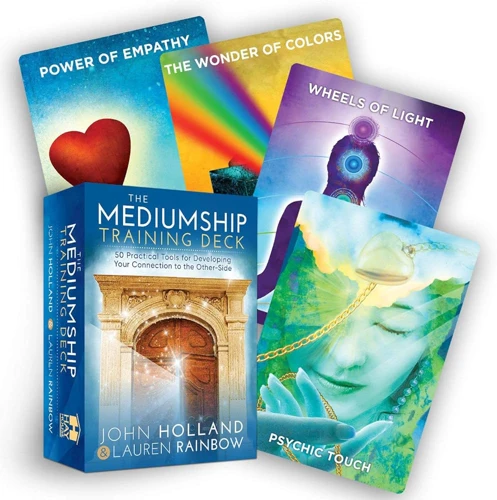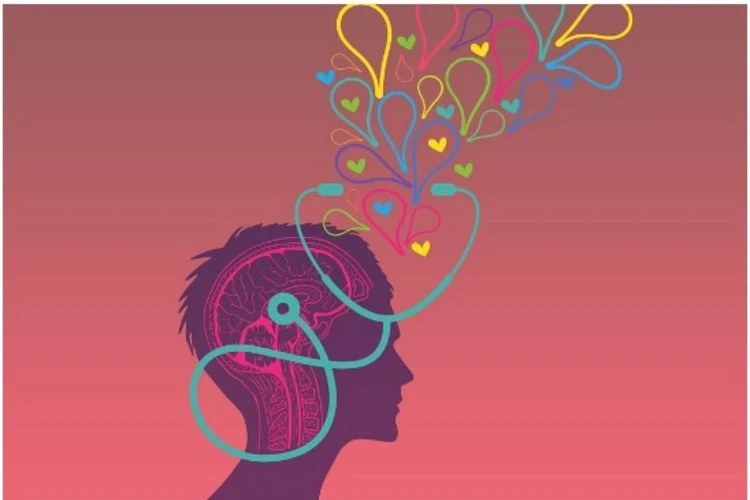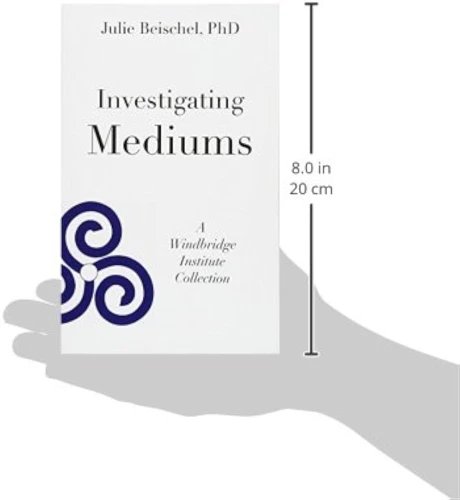Have you ever wondered if there is a way to connect with loved ones who have passed away? Mediumship, an ancient practice that has been passed down through generations, offers a potential bridge between the living and the deceased. It holds the promise of providing comfort, closure, and healing to those seeking solace after the loss of a loved one. In this article, we will delve into the world of mediumship, exploring its basics, different types, signs of connection, and how to develop mediumship abilities. We will also delve into the ethical responsibilities of mediums, examine the scientific perspectives on mediumship, debunk common misconceptions, and explore the spiritual healing that can be achieved through this practice. So, sit back, open your mind, and join us on this journey as we uncover the mysteries of mediumship and its connection to the afterlife.
Contents
- The Basics of Mediumship
- Types of Mediumship
- Signs of Connection
- Developing Mediumship Abilities
- Ethics and Responsibility
- Famous Mediums in History
- Scientific Perspectives on Mediumship
- Common Misconceptions
- Spiritual Healing through Mediumship
- Mediumship and the Afterlife
- Conclusion
-
Frequently Asked Questions
- What is the difference between a psychic and a medium?
- Can anyone become a medium?
- Do mediums always connect with specific loved ones?
- How do mediums receive information from spirits?
- Are all spirits that come through during a mediumship session friendly?
- Can mediumship sessions provide closure for grieving individuals?
- Are there any risks or dangers associated with mediumship?
- What role does meditation play in mediumship development?
- Are there any scientific studies or research on mediumship?
- How can mediumship contribute to spiritual healing?
- References
The Basics of Mediumship

To understand mediumship, we must first grasp the basics of this fascinating practice. Mediumship is the ability to communicate with spirits or entities from the spirit realm, facilitated by individuals known as mediums. Understanding Mediumship involves recognizing that mediums act as intermediaries between the living and the deceased, interpreting messages and information from the spirit world. It is important to note that not everyone is born with mediumistic abilities. While some individuals may possess natural talents from an early age, others may develop these skills over time through training and practice. If you’re curious about whether anyone can become a medium, click here to learn more about the potential for mediumship development. By having an open mind and cultivating a deep connection with the spiritual realm, mediums can tap into a world unseen by most, offering a sense of comfort and understanding to those seeking solace in the afterlife. If you want to uncover common misconceptions about mediumship, click here to dive deeper into the topic.
Understanding Mediumship
Understanding mediumship is key to exploring the profound connection between the living and the spirit realm. Mediumship is an ancient practice rooted in the belief that spirits can communicate with the living through specially gifted individuals known as mediums. These mediums act as intermediaries, relaying messages, and information from the spirit world to those seeking insight or closure. Mediumship is not limited to speaking with deceased loved ones; it can also involve communication with angels, guides, or other spiritual entities. Mediums often use their intuitive abilities to perceive and interpret subtle signs and messages from the spiritual realm. They may receive information through clairvoyance, clairaudience, or other psychic senses. Mediumship can bring comfort, healing, and guidance to individuals who are grieving or seeking answers about life’s mysteries. By understanding the intricate nature of mediumship and the connection between the physical and spiritual realms, we can embark on a journey of exploration and enlightenment. If you want to delve deeper into the topic of mediumship and its relationship with the spirit realm, you can find more information here.
How Mediums Communicate
Mediums communicate with the spirit realm through various methods and techniques. Here are some common ways in which mediums establish a connection and receive messages from the deceased:
- Clairvoyance: Some mediums possess the gift of clairvoyance, which allows them to see spiritual images and symbols. They may receive vivid visions or mental images that provide insights or messages from the spirit world.
- Clairaudience: Mediums with clairaudience can hear messages from spirits. They may hear voices, words, or sounds that convey information or convey the presence of a spirit. These auditory messages can be received internally within their minds or externally as if someone is speaking to them.
- Clairsentience: Mediums who are clairsentient can sense the emotions, feelings, or physical sensations of spirits. This ability allows them to experience the energy and essence of the deceased, enabling them to relay specific details and emotions to the recipients of the reading.
- Automatic Writing: Some mediums utilize automatic writing as a means of communication. They allow spirits to guide their hands to write messages, often receiving information that they may not consciously be aware of. This form of communication can provide detailed and personal messages from the spirit world.
- Trance Channeling: In trance channeling, mediums enter a deep state of altered consciousness, allowing the spirit to temporarily take control and communicate through them. The mediums may speak in a different voice, adopt unique mannerisms, or convey messages from the spirit directly.
- Symbolic Interpretation: Mediums may receive messages through symbolic representations. These symbols can come in the form of images, numbers, or objects that hold significant meaning to the recipient or the spirit trying to communicate. Interpreting these symbols requires intuitive understanding and connection with the spirit world.
Each medium has their own unique way of communicating with spirits, and these methods may vary depending on the individual and the specific spirit they are connecting with. It is important to note that mediums are not in control of the communication process, but rather act as conduits for the messages to be relayed from the other side. Through their abilities and the various communication methods available, mediums offer a glimpse into the realm of the departed, bringing comfort and closure to those seeking contact with their loved ones.
Types of Mediumship

Mediumship encompasses different approaches and techniques through which individuals can communicate with the spirit realm. These various forms of include physical mediumship, mental mediumship, and trance mediumship. In Physical Mediumship, the medium becomes a channel for physical manifestations, such as ectoplasmic entities, spirit materialization, or table tipping. Mental Mediumship involves receiving information, messages, or impressions from spirits and transmitting them to the recipient mentally or verbally. This form often includes clairvoyance (seeing), clairaudience (hearing), and clairsentience (feeling) abilities. On the other hand, Trance Mediumship is characterized by the medium entering an altered state of consciousness, allowing a spirit entity to communicate directly through them. This method often includes deep trance and light trance variations. Each type of mediumship has its own unique characteristics and methods of communication with the spiritual realm, providing diverse avenues for connecting with the deceased.
Physical Mediumship
Physical mediumship is a remarkable form of mediumship that involves the manipulation of energy and matter in the physical world. This type of mediumship focuses on producing tangible effects, allowing spirits to interact with the physical environment and communicate with the living. Here are some key characteristics and phenomena associated with physical mediumship:
1. Materialization: One of the most remarkable aspects of physical mediumship is the ability of spirits to materialize and become visible or tangible to those present. This can involve the manifestation of partial or full physical forms, allowing loved ones from the spirit realm to make their presence known.
2. Direct voice: Physical mediums may possess the ability to produce a voice that is not their own, known as direct voice communication. Through this phenomenon, spirits can communicate directly with sitters, often providing messages of comfort, guidance, and validation.
3. Table tipping and levitation: Physical mediums may facilitate the movement of physical objects through table tipping or even the levitation of objects. This phenomenon showcases the ability of spirits to manipulate energy and matter in the physical realm.
4. Automatic writing and painting: Another aspect of physical mediumship is the ability of mediums to channel spirits through automatic writing or painting. In this state, the medium’s hand may be guided by a spirit entity to produce written messages or artistic creations.
5. Trance states: Physical mediumship often involves the medium entering into a deep trance state, allowing spirits to overshadow their consciousness and use their physical body as a vessel for communication and interaction.
6. Physical phenomena: Other physical phenomena may occur during physical mediumship sessions, such as temperature changes, rappings, and the movement of objects without physical contact.
It is important to note that physical mediumship is a highly complex and rare form of mediumship. Mediums who specialize in physical mediumship dedicate significant time and effort to develop and refine their abilities. The phenomena associated with physical mediumship have been documented throughout history, and while skeptics may question its validity, many individuals have experienced profound encounters and witnessed inexplicable events during physical mediumship sessions.
Mental Mediumship
Mental mediumship is a type of mediumship that primarily involves the communication of spirits through the mind of the medium. This form of mediumship can take various forms, including clairvoyance, clairaudience, and clairsentience.
- Clairvoyance: Often referred to as “clear seeing,” clairvoyance is the ability to perceive images, symbols, or scenes in the mind’s eye. Mediums with clairvoyant abilities may receive visual impressions from the spirit realm, such as seeing a deceased loved one or witnessing significant events related to the sitter.
- Clairaudience: Known as “clear hearing,” clairaudience involves receiving messages, sounds, or voices from spirits within the medium’s mind. These messages may come through as thoughts or words that the medium hears internally. The medium then relays these messages to the sitter.
- Clairsentience: Also known as “clear feeling,” clairsentience is the ability to sense the emotions, physical sensations, or energies of spirits. Mediums with clairsentient abilities may experience the emotions or physical ailments that the deceased person once had, allowing them to provide detailed information and validations to the sitter.
Mental mediumship requires a heightened level of psychic sensitivity, as mediums must be open to receiving and interpreting the thoughts, feelings, and impressions from the spirit world. Through their psychic faculties, mediums can establish a connection with spirits and bridge the gap between the living and the deceased, offering insights, messages, and healing to those seeking guidance and closure. Mental mediumship is a profound and deeply personal experience for both the medium and the sitter, providing a unique opportunity to connect with the spirit realm and gain a greater understanding of life beyond the physical plane.
Trance Mediumship
Trance mediumship is a unique form of mediumship that involves the medium entering into a deep trance-like state to facilitate communication with spirits. During trance mediumship, the medium’s consciousness partially or completely steps aside, allowing spirits to utilize their body and voice to convey messages. This process requires a high level of trust and surrender on the part of the medium, as they allow themselves to be overshadowed by the communicating spirit. The depth of trance can vary, from a light trance where the medium is aware of their surroundings but allows the spirit to influence their thoughts and words, to a deep trance where the medium is completely unaware of their actions and has no memory of the communication afterward. Trance mediums may exhibit physical changes during the trance state, such as changes in voice, facial expressions, or even bodily movements. It is important to note that trance mediumship should only be practiced by experienced individuals who have developed a strong connection with the spirit realm and possess a solid understanding of protection and self-care.
Signs of Connection

When it comes to mediumship, there are various that indicate a link between the living and the deceased. These signs can come in different forms and can be subtle or more noticeable. Recognizing these signs is crucial for both mediums and individuals seeking messages from their loved ones on the other side. Some common signs include experiencing a sudden change in temperature, such as feeling a cool breeze or a warm sensation in the presence of spirits. Other signs may include the flickering of lights, objects moving or being displaced, or the strong presence of a familiar scent. Additionally, mediums may receive messages through dreams or receive specific symbols or images during their sessions. These signs serve as validation and reassurance that a connection has been established. In order to dive deeper into the topic of recognizing spirit signs and interpreting their meanings, click here to gain valuable insights into the spirit realm and its connection to mediumship.
Recognizing Spirit Signs
Recognizing spirit signs is an essential aspect of mediumship. These signs serve as messages from the spirit world, indicating the presence and communication of a departed loved one. Here are some common spirit signs to be aware of:
| 1. Synchronicities: | Pay attention to meaningful coincidences that occur in your life. These synchronicities can be a way for spirits to communicate with you. |
| 2. Dreams: | Spirits often visit us in our dreams, conveying messages or simply offering comfort. Keep a dream journal to document any vivid or unusual dreams you have. |
| 3. Signs in Nature: | Look for signs in nature that hold personal significance, such as feathers, butterflies, or specific animals. These can be meaningful messages from the spirit world. |
| 4. Electrical Interference: | Spirits can manipulate energy, leading to unexplained electrical disruptions like flickering lights or devices turning on and off. Take note of these occurrences. |
| 5. Intuitive Feelings: | Trust your gut instincts and intuitive feelings. Spirits may communicate through subtle intuitive nudges or a sense of their presence. |
| 6. Symbolic Objects: | Spirit signs can appear in the form of symbolic objects that hold special meaning for you or your departed loved one. Pay attention to any significant items that come into your awareness. |
Remember, not all signs may manifest in the same way for everyone, and it’s essential to develop your own understanding of the signs that resonate with you personally. By keeping an open mind, being receptive to these signs, and maintaining a connection with the spirit realm, you can enhance your ability to recognize and interpret spirit messages.
Messages from the Other Side
When it comes to mediumship, one of the most intriguing aspects is receiving messages from the other side. Mediums act as conduits, relaying messages and information from loved ones who have passed away. These messages can provide comfort, healing, closure, and valuable insights. Mediums may receive messages in various ways, including through clairvoyance (visions), clairaudience (hearing), or clairsentience (feeling). The messages can come in the form of words, images, symbols, emotions, or even physical sensations. It is crucial for mediums to deliver these messages accurately and with sensitivity, ensuring that they convey the essence and intention of the spirit communicator. These messages often carry profound meaning and personal significance to the recipients, offering a sense of connection and validation. Whether it’s a loving message, guidance, advice, or an apology, the messages from the other side can bring solace and peace to those seeking reassurance and a continued bond with their departed loved ones. It is a beautiful and awe-inspiring experience that shows the power of mediumship in bridging the gap between the living and the deceased.
Developing Mediumship Abilities

Developing mediumship abilities requires dedication, practice, and a deep understanding of the spiritual realm. The Importance of Meditation cannot be overstated when it comes to honing these skills. By engaging in regular meditation practices, mediums can quiet their minds, raise their vibrations, and develop a heightened sense of focus and awareness. This allows them to better connect with the spirit world and receive messages more clearly. Strengthening intuitive skills is another crucial aspect of mediumship development. Strengthening Intuitive Skills involves learning to trust one’s intuition, paying attention to subtle signs and sensations, and fine-tuning the ability to distinguish between one’s own thoughts and messages from the spirit realm. This can be achieved through activities like journaling, practicing psychic exercises, and participating in development circles where mediums can support and learn from one another. By incorporating these practices into their daily lives, individuals can enhance their mediumistic abilities and embark on a journey of spiritual growth and connection.
The Importance of Meditation
Meditation plays a vital role in developing mediumship abilities and is often considered a cornerstone practice for individuals seeking to enhance their connection with the spirit realm. lies in its ability to quiet the mind, cultivate inner stillness, and open oneself to spiritual energies. By setting aside dedicated time for meditation, mediums can create a sacred space where they can relax, focus their attention, and achieve a heightened state of awareness. Through regular meditation practice, mediums can strengthen their intuitive faculties, allowing them to receive messages and information from the spirit world more clearly and accurately. Additionally, meditation helps mediums develop their psychic senses, such as clairvoyance, clairaudience, and clairsentience, enabling them to perceive spiritual phenomena and communicate with spirits on a deeper level. It is also essential for mediums to establish a strong energetic connection with their spiritual guides and higher self, as this connection serves as a conduit for spiritual communication. Dedicating time to incorporate meditation into one’s daily routine is crucial for honing mediumship abilities and fostering a harmonious relationship with the spiritual realm.
Strengthening Intuitive Skills
Strengthening intuitive skills is a crucial aspect of developing mediumship abilities. Intuition serves as a bridge between the physical and spiritual realms, allowing mediums to receive and interpret messages from the spirit world. There are various techniques and practices that can help individuals enhance their intuitive abilities. One effective method is meditation, which allows individuals to quiet their minds, increase their awareness, and open themselves up to spiritual guidance. Regular meditation practice can cultivate a heightened sense of intuition and attunement to the energies around them. Additionally, keeping a journal to record intuitive experiences, dreams, and synchronicities can help individuals become more aware of their intuitive insights and patterns. Another approach to strengthen intuitive skills is to trust one’s instincts and act upon them. By learning to rely on their inner guidance and gut feelings, individuals can develop a stronger connection with their intuitive abilities. Finally, surrounding oneself with supportive and like-minded individuals who are also interested in developing their intuitive skills can create a nurturing environment for growth and learning. By sharing experiences, insights, and techniques, individuals can learn from one another and further enhance their intuitive capabilities. So, whether it’s through meditation, journaling, trusting instincts, or building a supportive community, there are numerous ways to strengthen intuitive skills and deepen one’s connection to the spiritual realm.
Ethics and Responsibility

When it comes to mediumship, ethics and responsibility play a vital role. Respecting Boundaries is paramount for mediums, as they must be mindful of the emotional and psychological well-being of their clients. This means understanding the limits of their abilities and not overstepping personal boundaries. Additionally, mediums have a Responsibility to communicate messages from the spirit world with honesty, integrity, and compassion. They must prioritize the well-being of their clients and provide them with the necessary support and guidance. Another crucial aspect of ethical mediumship is the Provision of Healing and Closure. Mediums should strive to offer comfort, healing, and closure to those who seek their services. This entails delivering messages with sensitivity and understanding, allowing individuals to find solace in connecting with their departed loved ones. By upholding these ethical principles, mediums honor the sacredness of their work and create a safe and supportive space for their clients to heal and find peace.
Respecting Boundaries
Respecting boundaries is a crucial aspect of practicing mediumship ethically and responsibly. When communicating with spirits, it is essential to remember that they are individuals with their own autonomy and agency. Respecting boundaries means acknowledging and honoring the wishes and limits of the spirit being contacted. Mediums should never force communication or pry into sensitive information that the spirit does not wish to share. It is important to approach each interaction with sensitivity and compassion, allowing the spirit to guide the conversation and dictate the level of information they are comfortable revealing. By establishing clear boundaries and consent, mediums can create a safe and respectful space for both the living and the deceased. This respect for boundaries allows for a genuine and authentic connection, fostering trust and validation in the mediumship process. Ultimately, respecting boundaries is not only an ethical obligation but also a way to ensure the well-being and dignity of all parties involved in the mediumship experience.
Providing Healing and Closure
When it comes to mediumship, one of the significant roles that mediums play is providing healing and closure. Through their ability to connect with the spirit world, mediums can offer a profound sense of comfort and solace to individuals who have experienced the loss of a loved one. The experience of connecting with a departed loved one can bring about a sense of relief, knowing that their spirit lives on and that they are at peace. The messages received during a mediumship session can often provide reassurance, offering guidance, forgiveness, or the opportunity to express unsaid words or unresolved emotions to ease any lingering burdens. This process of healing and closure can be instrumental in helping individuals navigate their grief and find inner peace. It is important to note, however, that not all mediumship sessions result in communication from specific individuals. The spirit world operates on its own timeline and may prioritize what messages are most beneficial for the recipient at a particular time. Through the gentle guidance and support of a skilled medium, individuals can begin to find healing and closure as they navigate the delicate path of grief and loss.
Famous Mediums in History

Throughout history, there have been several noteworthy individuals who have made significant contributions to the field of mediumship. These famous mediums in history have left a lasting impact and have paved the way for the recognition and acceptance of mediumship as a legitimate practice. One such figure is Madame Helen Blavatsky, a Russian occultist and author who co-founded the Theosophical Society. Blavatsky is known for her exploration of spiritualism and her teachings on esoteric philosophy. Another prominent figure is Daniel Dunglas Home, a Scottish medium who gained international fame during the 19th century for his ability to perform extraordinary physical phenomena during séances, such as levitation and materialization of objects. Home’s feats left audiences and investigators perplexed and intrigued. Moving into the 20th century, we encounter the renowned medium Edgar Cayce, often referred to as the “Sleeping Prophet.” Cayce is famous for entering a trance-like state and delivering accurate and detailed health readings and prophecies. His work not only brought comfort and healing to countless individuals but also spurred interest in the scientific investigation of psychic phenomena. These are just a few examples of the remarkable individuals who have left a lasting imprint in the realm of mediumship. Their contributions have helped shape the field and inspire current and future generations of mediums to embrace their abilities and explore the depths of spiritual communication.
Scientific Perspectives on Mediumship

When it comes to mediumship, there has been ongoing debate and exploration from a scientific perspective. In recent years, numerous studies and research have aimed to shed light on the validity and authenticity of mediumistic abilities. These seek to examine the evidence and provide a deeper understanding of this mystical practice. Researchers have conducted experiments, gathered testimonials, and analyzed the experiences of both mediums and their recipients in an effort to unravel the mysteries surrounding mediumship. It is fascinating to explore how scientific analysis can intersect with spiritual beliefs and personal experiences. By delving into the studies and research conducted in the field, we can gain insights into the connections between the living and the spirit world, opening up new avenues for dialogue and exploration. By exploring the evidence surrounding mediumship, we can expand our understanding and perhaps even challenge long-held assumptions.
Studies and Research
When it comes to the world of mediumship, there have been numerous studies and research conducted to explore its validity and understand its mechanisms. These studies aim to provide scientific evidence and a deeper understanding of the phenomenon. One notable study was conducted by the Windbridge Research Center, which focused on mediumship readings and the accuracy of information provided. The results showed that there were instances where mediums were able to provide specific and accurate details about deceased individuals that they could not have known through conventional means. This suggests that mediumship has the potential to tap into information from the spiritual realm. Another interesting research area is the use of brain imaging techniques, such as fMRI scans, to examine the brain activity of mediums during psychic experiences. These studies have revealed intriguing patterns and differences in brain activity compared to non-mediums, indicating that there may be unique neural processes associated with mediumistic abilities. Research has also explored the role of psychological factors in mediumship, such as the influence of belief systems and the impact of the sitter’s interpretation on the reading. These studies shed light on the complex interplay between the medium, the sitter, and the spiritual realm. While more research is still needed to fully understand the nature of mediumship, these studies provide valuable insights into this intriguing phenomenon.
Exploring the Evidence
When it comes to mediumship, exploring the evidence is crucial in order to gain a deeper understanding of this phenomenon. While some may dismiss mediumship as mere superstition or trickery, there have been numerous studies and research conducted to shed light on its validity. Exploring the evidence entails examining the various methods used to test the abilities of mediums and the results obtained. These include controlled experiments, double-blind studies, and statistical analysis of the information provided by mediums. Researchers have also explored the consistency and accuracy of the messages received from spirits, often comparing them to known facts that were not accessible to the medium. Additionally, advancements in technology have allowed for the use of objective measures, such as brain imaging and physiological responses, to further investigate the legitimacy of mediumistic abilities. It is important to note that while there is evidence supporting the existence of mediumship, not all claims made by mediums have been scientifically validated. Skepticism and critical thinking are necessary when evaluating the evidence and discerning between genuine mediumistic experiences and potential charlatanism. By delving into the scientific perspectives on mediumship, we can strive to separate fact from fiction and gain a deeper appreciation for the potential of this ancient practice.
Common Misconceptions

There are several common misconceptions surrounding mediumship that have led to skepticism and misunderstandings. By addressing these misconceptions, we can gain a clearer understanding of the true nature of mediumship and its potential benefits.
- Mediums are frauds: One of the most prevalent misconceptions is that all mediums are frauds, intentionally deceiving people for personal gain. While there have been cases of fraudulent individuals claiming to be mediums, it is essential to differentiate between genuine mediums and fraudulent ones. Genuine mediums have a sincere desire to help others and connect with the spirit realm.
- Mediums can predict the future: Another misconception is that mediums possess the ability to predict future events with absolute certainty. While mediums may receive intuitive insights and messages from spirits about potential outcomes, the future is not set in stone. Free will and individual choices can influence and change future events.
- Mediumship is demonic or evil: Some believe that mediumship is associated with dark or negative energies. However, mediumship is a practice that can be rooted in love, healing, and compassion. It allows for connections with deceased loved ones and offers comfort and closure to those grieving.
- Mediumship is only for the chosen few: It is commonly thought that mediumship is a rare and exclusive gift reserved for a select few individuals. While some individuals may naturally possess stronger mediumistic abilities, mediumship is not limited to a specific group or lineage. With dedication, education, and practice, many people can develop and enhance their mediumship skills.
- Mediums are always accurate: It is important to understand that mediums are not infallible and may not always provide 100% accurate information. Various factors can influence the accuracy of the messages received, such as the medium’s state of mind, the clarity of the spirit communication, and the interpreter’s understanding of the messages.
By dispelling these misconceptions and gaining a more accurate understanding of mediumship, we can approach this practice with an open mind and appreciation for its potential to help bridge the gap between the living and the deceased.
Spiritual Healing through Mediumship

Mediumship not only serves as a means of connection with the deceased but also holds the potential for spiritual healing. Through the process of mediumship, individuals can experience a profound sense of healing, closure, and peace. Connecting with Loved Ones who have passed away can bring a deep sense of comfort and reassurance to those left behind, knowing that their loved ones are still present in some form. Messages received through a medium can provide guidance, support, and even the opportunity to reconcile unresolved emotions or conflicts. Furthermore, Gaining Peace and Solace through mediumship can help individuals navigate the grieving process and find solace in the knowledge that their loved ones continue to exist in the spiritual realm. This allows for the healing of emotional wounds and a renewed sense of hope and purpose in life. Mediumship truly offers a unique avenue for spiritual healing, offering a bridge between the physical and spiritual worlds.
Connecting with Loved Ones
Connecting with loved ones who have passed away is one of the most profound and sought-after experiences in mediumship. It offers a sense of comfort, closure, and healing to those who are grieving. There are several ways in which mediums facilitate this connection:
1. Evidential Mediumship: Evidential mediumship focuses on providing concrete evidence of the presence of the loved one, such as specific names, memories, or personal details known only to the individual and the deceased. This evidence serves as validation to establish a strong connection between the medium and the spirit, allowing the recipient to feel a sense of reassurance and confirmation.
2. Messages and Communication: Mediums often act as channels for messages from the spirit world. They may receive and relay messages from loved ones, conveying their emotions, thoughts, and advice to bring comfort and guidance to the living. These messages can provide closure, healing, and even resolutions to unresolved issues, allowing for emotional release and a sense of peace.
3. Physical Gestures and Signs: Loved ones in the spirit realm may also communicate through physical gestures and signs. These can be as subtle as a gentle touch, a familiar fragrance, or a sudden change in temperature. The mediums act as interpreters of these signs, helping individuals recognize and understand the presence and messages from their departed loved ones.
It is important to approach these connections with an open mind and heart, as the messages and signs may not always be what we expect or anticipate. Through the unique abilities of mediums, individuals can experience the profound joy of reconnecting with their loved ones, gaining a sense of peace, healing, and solace in the process.
Gaining Peace and Solace
When someone we love passes away, it can leave us with a profound sense of grief and longing. One of the powerful aspects of mediumship is its potential to bring a sense of peace and solace to those who are grieving. Through the connections made with the spirit world, mediums can convey messages, memories, and reassurances from our departed loved ones. This can provide immense comfort, as it allows us to know that our loved ones are still with us in some form, watching over and supporting us. The messages received during a mediumship session can be deeply personal and filled with love, offering validation and closure to those left behind. It can serve as a reminder that death is not the end, but rather a transition into a different existence. By experiencing the presence of our loved ones through a medium, we can find solace in knowing that they are at peace and that their love continues to surround us. This can greatly assist in the healing process, offering a glimmer of hope and easing the burden of grief. The gift of gaining peace and solace through mediumship is truly extraordinary, providing a sense of inner calm and a renewed perspective on life and the afterlife.
Mediumship and the Afterlife
Mediumship offers profound insights into the afterlife, providing a glimpse into what lies beyond our physical existence. Through mediumistic connections, individuals can receive messages and validations from their departed loved ones, offering a sense of comfort, closure, and reassurance. go hand in hand, as mediums act as conduits for communication between the living and those who have passed away. These connections can provide invaluable insights into the nature of the afterlife, the continuation of relationships beyond death, and the existence of a spiritual realm. Mediums often relay detailed information from spirits, including personal memories, experiences, and messages that offer solace and peace to those seeking healing. Understanding the afterlife through the lens of mediumship allows individuals to find consolation and a renewed sense of connection with their departed loved ones. Whether it is gaining insights into the nature of the afterlife or nurturing ongoing relationships with spirits, mediumship provides a bridge that helps us make sense of the mysteries that exist beyond our earthly realm.
Insights into the Afterlife
Mediumship offers intriguing insights into the afterlife, providing a window into the realm beyond our physical existence. Through their connection with spirits, mediums are able to gather information and relay messages that shed light on what happens after we pass away. Here are some key points to consider:
- Continued existence: Mediums often receive evidence that suggests consciousness and identity persist beyond death. Messages from loved ones who have crossed over can offer details and personal anecdotes that validate their continued presence in the afterlife.
- Levels of existence: Mediumship suggests that there are different levels or planes of existence in the afterlife. Some spirits may linger in the earthly realm, while others move on to higher spiritual dimensions. The ability to connect with spirits from various levels can provide a more comprehensive understanding of the afterlife.
- Spiritual growth and evolution: Insights from the afterlife often highlight the concept of ongoing spiritual growth and evolution. The messages received through mediumship often emphasize the importance of learning, growth, and the resolution of unresolved issues even after death.
- Continuing relationships: Mediums can bridge the gap between the living and the deceased, fostering ongoing relationships. Messages from loved ones in the afterlife can provide comfort, guidance, and assurance that they are still connected to and watching over their living counterparts.
- The nature of the afterlife: Although descriptions of the afterlife vary depending on the spirit and the medium, common themes often emerge. Concepts such as love, peace, forgiveness, and spiritual transformation are frequently conveyed, suggesting a realm that transcends the limitations of earthly existence.
- Karmic consequences: Some mediums receive insights into the workings of karma and how it continues to shape spiritual journeys after death. Messages may convey that actions in past lives or during the current life influence the path and experiences of individuals in the afterlife.
While individual experiences and interpretations may vary, mediums provide valuable insights into the afterlife, offering a glimpse into what awaits us beyond this physical realm.
Continuing Relationships
When it comes to mediumship, one of the most profound aspects is the idea that relationships with loved ones can continue beyond physical death. This concept suggests that death does not sever the bond between souls. Instead, it transforms and evolves into a different form of connection. In these continuing relationships, spirits may offer guidance, support, and even participate in the lives of their loved ones who are still living. Some individuals have reported experiences where they feel the presence of their deceased loved ones, receive signs, or hear their voices in moments of need or reflection. These ongoing connections can bring a great deal of comfort and healing to those who are grieving. While skeptics may dismiss these experiences as mere coincidences, those who have personally encountered these continuing relationships believe in the profound and meaningful connections that transcend the physical realm. Through mediumship, individuals can gain a deeper understanding of the afterlife and the enduring nature of love and relationships. Whether it is a simple sign, a dream visitation, or a message delivered through a medium, the continuation of relationships with deceased loved ones offers solace and an opportunity for continued growth and healing.
Conclusion
In , mediumship serves as a powerful tool that bridges the gap between the living and the deceased. Throughout this article, we have explored the basics of mediumship, delving into understanding mediumship and how mediums communicate with spirits. We have also covered different types of mediumship, including physical mediumship, mental mediumship, and trance mediumship, each offering unique approaches to connecting with the spirit realm. Recognizing signs of connection and receiving messages from the other side are key aspects of mediumship. Developing mediumship abilities requires dedication, with meditation and the strengthening of intuitive skills playing pivotal roles in honing these talents.
As mediums carry out their practice, they must uphold ethics and responsibility. Respecting boundaries and providing healing and closure to those seeking connection are essential aspects of the mediumship journey. Looking back at history, we can find famous mediums who have made significant contributions to the field. Furthermore, scientific perspectives on mediumship offer intriguing studies and research, exploring the evidence of communication with the spirit world.
Addressing common misconceptions, mediumship stands as a practice rooted in spiritual healing. Through mediumship, individuals can forge connections with loved ones who have passed away, gaining peace and solace in the process. This practice also provides insights into the afterlife and the continuation of relationships beyond physical existence.
In Conclusion, mediumship invites us to embark on a journey of exploration and understanding. It pushes the boundaries of our understanding of life and death, offering a glimmer of hope and reassurance to those seeking connection with the spiritual realm. So, whether you approach mediumship with skepticism or curiosity, it remains an ancient practice that has stood the test of time, providing comfort and solace to countless individuals throughout history.
Frequently Asked Questions
What is the difference between a psychic and a medium?
A psychic is someone who taps into their intuitive abilities to gain insight into a person’s past, present, or future. On the other hand, a medium specifically focuses on communicating with spirits or entities from the spirit realm.
Can anyone become a medium?
While mediumistic abilities can be developed, not everyone possesses the natural inclination towards mediumship. Some individuals may have a stronger connection to the spirit realm from an early age, while others may need to invest time and effort into honing their skills.
Do mediums always connect with specific loved ones?
No, mediums have no control over which spirits come through during a session. They simply act as a channel for communication, allowing any spirits who wish to convey messages to come forward.
How do mediums receive information from spirits?
Mediums receive information through various methods, such as clairvoyance (seeing), clairaudience (hearing), or clairsentience (feeling). The specific method may vary depending on the medium’s individual abilities.
Are all spirits that come through during a mediumship session friendly?
Yes, mediums work with the intention of connecting with spirits who are benevolent and have positive intentions. However, it’s always important to be cautious and use discernment when interacting with any spiritual entity.
Can mediumship sessions provide closure for grieving individuals?
Yes, mediumship sessions can often provide comfort and closure for those who have lost loved ones. Messages from the other side can offer validation, healing, and a sense of peace to individuals seeking solace after a loss.
Are there any risks or dangers associated with mediumship?
While mediumship itself is generally regarded as safe, it is important for mediums to maintain ethical boundaries and protect their own energy. Additionally, individuals seeking to connect with spirits should exercise caution and approach the practice with an open mind.
What role does meditation play in mediumship development?
Meditation is a crucial tool for mediumship development as it helps quiet the mind, enhance focus, and cultivate a deeper connection with the spiritual realm. Regular meditation practice can strengthen a medium’s intuitive abilities and attunement to spirit communication.
Are there any scientific studies or research on mediumship?
Yes, there have been numerous scientific studies conducted on mediumship, exploring its validity and the potential for genuine communication with the spirit realm. These studies often focus on the accuracy of mediumistic messages and the consistency of information provided.
How can mediumship contribute to spiritual healing?
Mediumship can contribute to spiritual healing by offering individuals the opportunity to connect with their loved ones who have crossed over. This connection can bring comfort, provide closure, and promote a sense of peace, allowing for healing and emotional growth.







